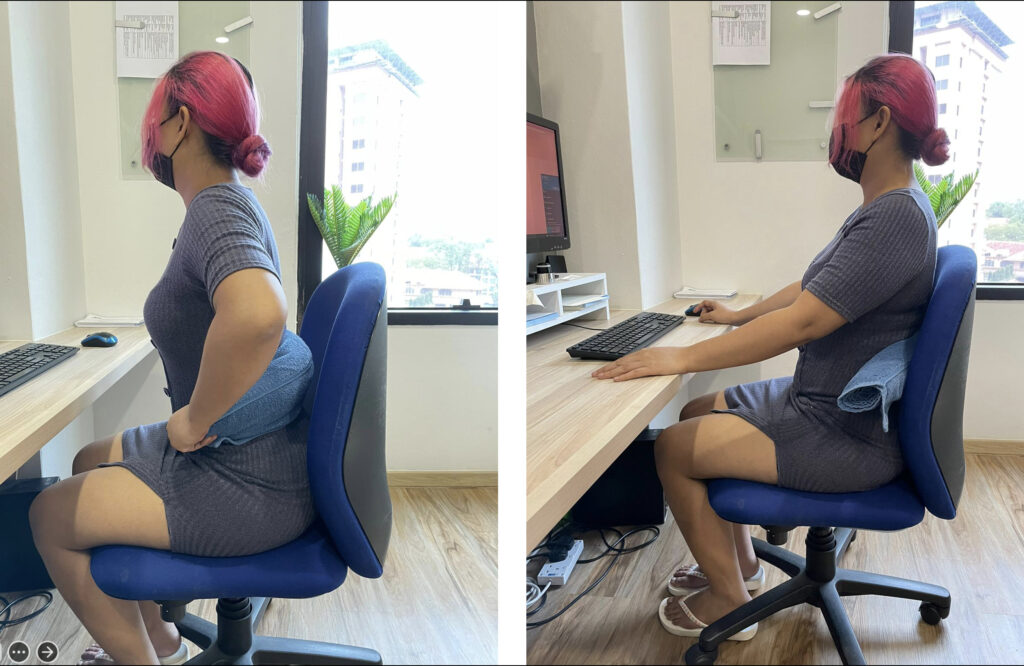Better Posture, Better You!
How often do you sit at your desk? Do you spend 8, 10 or even 12 hours a day sitting? Do you feel the strain on your back after a long period of time?
As humans, we are designed to move. Prolonged static postures can cause a build up of stress in our body and in order to release it, we need to move around. Movement is our body’s way of balancing things out. It’s good for us!
Take this for example: Bend your finger all the way back to it’s limit. Do you feel a strong stretch? Now, hold it for one minute or so and you’ll start to feel uncomfortable. Imagine how painful it can get if you keep the pressure on for an hour! Your sensory nerve endings and pain receptors in your hand tell you pretty quickly not to do this and to move to relieve the pain. So why do we constantly do the same thing day in, day out, to our spines while sitting at the computer?
Importance Of Our Spine
The spine is our body’s central support structure. It connects different parts of our musculoskeletal system, head, trunk, arms, and legs, and is therefore designed to take more load. At the same time though, it has less sensory receptors than our fingers from the example above.
This means that while a stressful situation occurs in our fingers and our brain informs us of it immediately, making us react and move, the same doesn’t happen in our far less sensitive spine.
In other words, you may not be aware of stress in your spine even though it is there. This may possibly be the reason why we sit for hours in the same position without doing anything about it. We just don’t feel it until it’s too late!
Negative Effects Of Improper Sitting Position
We have all seen elderly people who are in a very stooped or round-shouldered position and are unable to straighten themselves. Well, it doesn’t just happen overnight. It is a gradual decline and a giving in to gravity. “If you don’t use it you will lose it!” and that phrase is so true about good posture.
If we sit badly or incorrectly for a prolonged period, we will lose our ability to sit upright and slouching can become permanent. Especially in this age of advanced technology, we are spending more time than ever sitting at desks and the ’elderly stoop’ is no longer just an elderly phenomenon. It’s happening to younger and younger people.
Many of you who are sitting while reading this are getting a little concerned! Fortunately, you don’t have to worry. Here are some tips and tricks that can prevent the ‘elderly stoop’ from happening.
Tip #1: Start Moving
It’s important to sit correctly when you’re working at a desk for prolonged periods, but even if you are in the most perfect sitting position, you will still need to move around regularly to prevent a build up of pressure and keep the spine happy and in balance.
Something as simple as standing up every hour and moving around your desk can make a huge difference and keep your body happy. Standing desks or desk risers are great for this. Also, try setting a timer on your computer to remind you to move every hour.
Tip #2: Support Yourself
There are some amazing office chairs that make sitting up straight easy. However, we can find ourselves in unsupportive chairs that allow us to slouch all too easily due to gravity pushing us down. Sitting up straight involves using our anti-gravity muscles and therefore involves more effort.
So, how can we make this easier for you? Lumbar roll! A lumbar roll is designed to sit in the inward curve of your lower back to improve sitting posture. It’s a cheap and easy fix for a non-supportive chair. If you’re in a pinch, you can also create your own DIY lumbar roll using a towel:
- Roll up a towel about the size of your forearm (If you were to put your arm behind your back whilst seated, you would find that your arm is just about the right size to fill in the space that needs support
- Sit right back in the chair so that there is no space between the chair and your butt
- Place the roll in the waist space and sit back against it
- You should be able to relax in a straighter position

Although the height of your computer screen, desk height, type of computer, and other ergonomic factors are also all very important to consider, having a good back support is a very good start. Your body will definitely appreciate it!
We’ve Got Your Back
If you’re still experiencing pain and tension despite your best efforts, seek help from a physiotherapist! A physio can help to tailor an exercise program to your specific body needs and with the considerations of your specific lifestyle and medical background.
Written By: Rowena Chance, MCSP (Chartered Physiotherapist UK)
Rowena is a highly experienced Physiotherapist and Clinical Pilates Instructor with over 36 years of experience working in large hospitals, private practice and even ‘on the field’ at the Hong Kong Sevens Rugby tournament. While she has a strong background in sports physiotherapy, her clinical interests includes women’s health particularly ante- and post- natal problems and pelvic disorders often presenting as hip or back pain.

